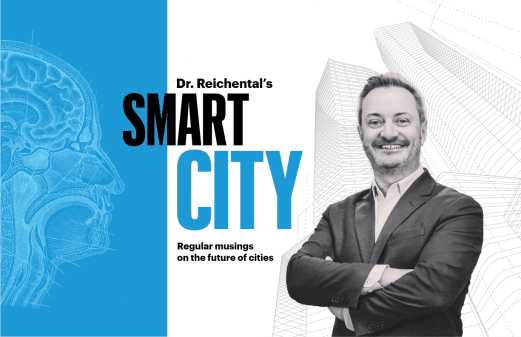10 smart cities to watch

Cities across the country (and the world) are turning to technology to better connect their communities, improve citizen services, and perhaps most of all, find more intelligent ways to manage their resources.
A closer look at the evolution of “smart cities” reveals a rising tide of innovation in cities large and small across the U.S., as StateScoop reported this week (See Cities of the future: The big shift to ‘Smart’) — and a range of approaches.
Indeed, as StateScoop set out to identify some of the nation’s smart cities, we found that cities are often charting distinctive paths toward smarter operations, based on a mix of municipal priorities, available budgets and public-private partnerships.
At the same time, what those cities have in common is their vision to be more connected, and operate more efficiently and productively, along with a focus on improving city services.
For large cities, such as New York City, that means finding ways to connect all citizens — regardless of economic status — to digital city services, according to Chief Technology Officer Minerva Tantoco. “The power of smart city technology lies in its use in the communities which are the most in need,” Tantoco said.
In Charlotte, North Carolina, the smart city vision is about sustainability. Officials are working with Envision Charlotte to help make the Queen City’s air, water, energy and waste more sustainable and healthier for its citizens — an idea that has picked up steam nationwide in a new “Envision America” movement.
From Austin, Texas’ embrace of its rapidly growing technology sector, to San Antonio’s approach to Internet of Things, cities are changing because of connectivity.
Whether it involves releasing a set of apps, like 311 interfaces or traffic light triggers, or rolling out a large-scale Wi-Fi mesh across an entire city, the following 10 cities are charting the course for how the city of the future will look.
StateScoop surveyed industry, associations and the public sector officials to identify 10 cities that are blazing trails in the rapidly evolving world of smart city innovations. While not a definitive list — clearly there are many municipalities taking exciting steps toward a more interconnected future — here are 10 smart cities to watch.
Home to a rapidly growing technology sector, Austin has become an incubator for innovation. Stephen Elkins, Austin’s chief information officer, said the city is tapping into local brainpower to deliver better citizen services and improve city operations.
Elkins pointed to the success of the city’s 311 mobile app, which allows users to report anything from a broken sign to a dirty city park and uses geolocation to pinpoint where the complaint was made.
Austin has launched a number of apps for its citizens. One designed for cyclists lets the city’s traffic light system know when a bicycle is waiting at an intersection. The city also uses analytics to ensure fire and police departments are sufficiently staffed during busy periods of the day, month, season or year.
Marc Ott, city manager; Mayor Steve Adler; Elkins.
Like other cities, Austin is working to roll out public Wi-Fi for citizens. The Wi-Fi network would also give city departments the Internet backbone to deploy more smart-enabled technology. In addition, Elkins said he hopes to continue to improve the city’s open data portal. The city is also in the process of forming a public-private advisory board on smart city and technological issues.
— Jake Williams
Return to the list introduction.
: The Mayor’s Office of New Urban Mechanics works with Boston’s Department of Innovation and Technology as a research and development group for a range of projects. Office co-chairman Nigel Jacob said the group’s mission is to build “technology with human values at their heart,” and the office has worked on dozens of projects over the last few years to help make Boston smarter.
: Jacob said the office took aim at a major pain point in Boston: parking. The group partnered with the local company “TicketZen” to offer an app that lets people pay parking tickets from their smartphones. The office also helped the city launch a separate “ParkBoston” app, which lets drivers pay for parking at certain city meters using their phones or even feed the meter remotely.
: In a nine-week pilot program for the “ParkBoston” app starting in January, residents downloaded the app 15,000 times and used it for 12,000 transactions.
: Jacob; Kris Carter, office co-chairman.
: The city is finishing a bid to make its more than 8,000 parking meters accept payment through “ParkBoston.”
: http://newurbanmechanics.org/
— Alex Koma
Return to the list introduction.
: As Boulder mulls creating a city-owned utility, the city’s information technology department expanded its data analytics efforts to show how the move would affect residents — and the city itself. Director of Information Technology Don Ingle said the city has been collecting internal and external data to help lay out a roadmap for how Boulder can meet its rigorous energy reduction goals in the coming years.
: Xcel Energy currently provides the city’s electricity, but growing frustration with the company’s alternative energy efforts has prompted the city to create the “Boulder Energy Future Project,” to examine the city’s options. Ingle’s staff created several models using energy grid analysis software to demonstrate how creating a city utility could affect electric bills and reduce carbon emissions in Boulder.
: Boulder’s City Council has used the models in a series of meetings about forming a city utility.
: Ingle; Heather Bailey, executive director of energy strategy and electric utility development.
: The city is currently working with state regulators to move forward with creating a city-owned utility and could take over the management of the grid by late 2017. If that happens, Ingle believes his department could begin experimenting with Internet of Things technology to manage the electric grid more efficiently.
: https://bouldercolorado.gov/information-technology
— Alex Koma
Return to the list introduction.
: What do Burlington and the film “Moneyball” have in common? Much like how Billy Beane’s Oakland Athletics used analytics to improve his team, Burlington tries to “use evidence, not intuition” to drive decisions, Mayor Miro Weinberger said.
: After working with IBM engineers as part of the company’s “Smarter Cities Challenge” in 2013, the city kicked off a program to reduce energy use by teaming up with landlords of rental properties. In exchange for letting the Burlington Electric Department — the city’s municipally owned utility company — conduct “energy audits” on the properties, Weinberger said the city agreed to pay 75 percent of the cost of energy efficiency improvements.
: Burlington staff set an initial goal of conducting 50 audits as part of the new program. Weinberger said the city has “blown past” that benchmark with 84 audits completed so far, and they now aim to finish 100 before year’s end.
: Weinberger; Chief Innovation Officer Beth Anderson.
: Anderson took the reins of the city’s new Innovation and Technology Department in May, and Weinberger hopes she can help lead a variety of efforts in Burlington, including an expansion of its car sharing program and the regulation of ridesharing companies in the city.
: https://www.burlingtonvt.gov/
— Alex Koma
Return to the list introduction.
: Charlotte forged a relationship with nonprofit entity Envision Charlotte — a conglomeration of private industry, utility companies, universities and government officials that seeks to make Charlotte the most sustainable city in the world — to make the city more efficient. Focusing on air, water, energy and waste, the city aims to use this “public-private-plus” partnership to take action at little or no cost to the city’s residents by creating “living laboratories” to test new ideas and concepts.
: It was one of eight cities inducted in the Global Smart City and Community Coalition at the National Institute of Standards and Technology’s Global City Teams Challenge Expo in June. In addition, Charlotte won an award from the Clinton Global Initiative in 2010.
: Charlotte’s efforts in energy alone have saved citizens more than $10 million since the program’s inception in 2011.
: Amy Aussieker, director of Envision Charlotte; Rob Phocas, Charlotte’s sustainability director.
: The city aims to reduce its energy and water use, waste, and pollutant levels by 20 percent.
: http://www.envisioncharlotte.com
— Grayson Ullman
Return to the list introduction.
For Chicago, economics drives smart city initiatives. Whether it’s big data analytics, 311 service projects or its smart grid project, the Windy City is looking to use technology to lower costs and, eventually, save the city money. At the same time, the city is trying to expand how its population of more than 2.7 million residents accesses technology.
In 2014, the city kicked off its Smart Grid initiative at the same time northern Illinois electric utility Commonwealth Edison began installing smart meters across the city. As part of the program, Mayor Rahm Emanuel announced Retrofit Chicago, which encourages citizens to work with the city to cut their energy use by 20 percent.
Chicago has several pending smart city projects. It has invested in a high-speed, broadband communications network for first responders and public safety officials. In addition, the city has created an open data portal featuring more than 600 data sets, Chief Information Officer Brenna Berman said in a video. Berman said civic-minded software developers have used the data to help build apps and create new online services for the community.
Berman; Jonathan Lewin, commander of public safety information technology, Chicago Police Department; Smart Chicago Collaborative; Mayor Rahm Emanuel’s Office; Department of Innovation and Technology.
The city will continue advancing the Smart Grid project, as well as investments and operations in smart transportation technologies and open data.
— Jake Williams
Return to the list introduction
: Miami officials see a variety of ways for the city to deliver services more efficiently by making government as open as possible. To that end, Chief Information Officer Kevin Burns has initiated a series of projects to open up the city’s data collections. Initially, he said the move should cut down the amount of time city staff have to spend answering citizen inquiries, giving them more time to improve, or support new, services.
: The city’s new land management Web tool, called “iBuildMiami,” was developed to reduce red tape for contractors and developers in Miami. The website not only allows people to apply and pay for building permits, but also has a tracking system that streamlines the work of the city’s building and fire inspectors. Burns said the feature allows the city to schedule its inspectors’ arrival times more accurately and “not be like the cable company,” by showing users how many other sites are scheduled for inspection ahead of their own.
: Burns estimates the system has cut down on about 60,000 phone calls to the city per year from people hoping to know when their inspectors will arrive.
: Burns; Mayor Tomas Regalado.
: Miami has kicked off a series of open data efforts, working over the last 18 months to make all of its budget data available on an online portal. Burns said the city now hopes to move its building and zoning permit data online by the end of the year.
: http://www.miamigov.com/itd/
— Alex Koma
Return to the list introduction.
The Big Apple is aiming to be the most “tech friendly and innovative city in the world,” according to Minerva Tantoco, the city’s chief technology officer. Earlier this year, the city released its OneNYC plan, which, among other initiatives, uses technology to solve some of the city’s toughest urban problems across all five boroughs. New York City also released a new digital roadmap for civic engagement that introduces technology initiatives for modernizing systems within city government and puts a new emphasis on open government data.
“The power of smart city technology lies in its use in the communities which are the most in need,” Tantoco said. “It acts as a force multiplier of the benefits. To us, a smart city is an equitable city.”
: The city is in the process of building a municipal Wi-Fi network. Jeff Merritt, the director of innovation for the Mayor’s Office of Tech and Innovation, told StateScoop that the effort, LinkNYC, will result in the “world’s largest and fastest” municipal Wi-Fi network — and it’s all based out of the city’s aging pay phones.
“The Link network won’t cost taxpayers a penny; in fact, it will generate millions of dollars of revenue each year for the city through digital advertising,” Merritt said.
: For the city that never sleeps, the results of a data-driven smart city initiative are already presenting themselves. Merritt said the city’s use of data for city services like public safety, transportation and water management has already yielded significant results. In transportation alone, the city has reduced bus delays by nearly 20 percent through the introduction of traffic signal prioritization technology onto its fleet of public buses.
Tantoco; Merrit; the Mayor’s Office of Technology and Innovation.
New York wants to be the hub for smart city technology. Right now, the city is working to design and roll out neighborhood labs to allow companies to try out their civic technology innovations.
“New York City makes a great ‘living lab’ for smart city technologies that address urban problems, create communities and promote equity,” Tantoco said.
— Jake Williams
Return to the list introduction.
: San Antonio has spent the last decade laying fiber optic cable and building a wireless mesh network throughout the city. The infrastructure allowed San Antonio to embark on a variety of IT projects and take advantage of data streaming from the Internet of Things.
: Starting in 2007, Chief Information and Technology Officer Hugh Miller worked with transportation staffers in the city to connect each of San Antonio’s roughly 1,350 traffic lights to its network. Traffic engineers can now get a remote look at the state of traffic at each intersection via motion cameras installed on utility poles and control the lights remotely should they malfunction. The technology also helps the city control the timing of each series of lights without having to rely on weight sensors built into the road.
: Miller said the lights have helped the city reduce traffic congestion and accidents, resulting in major savings for San Antonio. He said the city has become more efficient since the installation of the system and its effectiveness “continues to increase.”
: Miller; Nora Chavez, CPS Energy board chair.
: Controllers for city’s traffic lights are slated to receive another round of upgrades. Starting this fiscal year and continuing for the next few years, Miller said his staff will improve the monitoring tools on the lights so the city can “react before citizens call” about malfunctions.
: http://www.sanantonio.gov/itsd/
— Alex Koma.
Return to the list introduction.
San Francisco Chief Information Officer Miguel Gamiño Jr. is working to create a fiber optic infrastructure that would allow the city to make more use of the Internet of Things and gather data more effectively.
In February, Gamiño and his team released the first version of a citywide connectivity plan, which called for a roll out of a municipal fiber network and public Wi-Fi. Since then, the city has started offering Wi-Fi in a number of public places. The CIO also touted San Francisco’s online business portal, a resource for companies looking to work with city government on tech projects.
Gamiño said there’s been an outpouring of praise for the connectivity project. Many residents have expressed their support on Twitter, using the #SFWiFi hashtag. The CIO also said the online business portal has allowed city government to connect with many local companies.
Mayor Ed Lee; Gamiño; the Department of Technology; Mayor’s Office of Civic Innovation; Open Data Office; Committee on Information Technology.
Gamiño hopes to push out the second version of the city’s connectivity plan and do more to use data to drive the city’s decisions.
— Jake Williams






